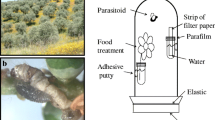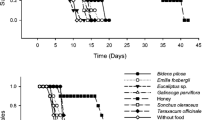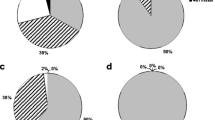Abstract
Chrysoperla carnea s.l. (Stephens) (Neuroptera: Chrysopidae) larvae are generalist predators feeding on many crop pests while adults feed on non-prey food. The knowledge about the nutritional suitability of non-prey food for adults in agroecosystems is crucial to establish conservation biological control strategies and is poorly known in olive groves, where C. carnea s.l. larvae prey on different pests. In this study, the effect of honeydew secreted by two hemipteran olive tree secondary pests and 11 plant species on the life-history parameters (survival, reproduction and development time) of C. carnea s.l. were analyzed. Insect pest honeydew from the olive agroecosystem and several plant species, blooming throughout the year, were found to improve C. carnea s.l. adult survival. Pollen consumption seems to be essential for reproduction. These findings are important for designing and implementing new conservation biological control approaches.



Similar content being viewed by others
References
Alrouechdi K (1984) Les chrysopides (neuroptera) en oliveraie. In: Gepp J, Aspöck H, Hölzel H (eds) Progress in world’s neuropterology. Proceedings of the 1st international symposium on neuropterology, Graz, Austria, pp 147–152
Arambourg Y (1984) La fauna entomológica del olivo. Olivae 2:39–44
Balzan MV, Wäckers FL (2013) Flowers to selectively enhance the fitness of a host-feeding parasitoid: adult feeding by Tuta absoluta and its parasitoid Necremnus artynes. Biol Control 67:21–31
Benjamini Y, Hochberg (1995) Controlling the false discovery rate: a practical and powerful approach to multiple testing. J R Stat Soc B 57:289–300
Bento A (1999) Contribuição para o estabelecimento de um programa de protecção integrada contra a traça da oliveira, Prays oleae (Bern.) em Trás-os-Montes. PhD thesis. Universidade de Trás-os-Montes e Alto Douro, Vila Real, Portugal
Bogdanov S, Ruoff K, Persano Oddo L (2004) Physico-chemical methods for the characterization of unifloral honeys: a review. Apidologie 35:S4–S17
Campos M, Ramos P (1983) Chrisopidos (Neuroptera) capturados en un olivar del sur de España. Neuroptera Int II 4:219–227
Comba L, Corbet SA, Hunt L, Warren B (1999) Flowers, nectar and insect visits: evaluating British plant species for pollinator-friendly gardens. Ann Bot Lond 83:369–383
Denisow B, Bożek M (2008) Blooming and pollen production of two Lamium L. species. J Apic Sci 52:21–30
Gharbi N, Dibo A, Ksantini M (2012) Observation of arthropod populations during outbreak of olive psyllid Euphyllura olivina in Tunisian olive groves. Tunis J Plant Prot 7:27–34
Gibson CM, Hunter MS (2005) Reconsideration of the role of yeasts associated with Chrysoperla green lacewings. Biol Control 32:57–64
Gonzalez D, Nave A, Gonçalves F, Nunes FM, Campos M, Torres L (2016) Effects of ten naturally occurring sugars on the reproductive success of the green lacewing, Chrysoperla carnea. BioControl 51:57–67
Gurr GM, Wratten SD (1999) FORUM ‘Integrated biological control’: A proposal for enhancing success in biological control. Int J Pest Manag 45:81–84
Hogervorst PAM, Wäckers FL, Romeis J (2007) Detecting nutritional state and food source use in field-collected insects that synthesize honeydew oligosaccharides. Funct Ecol 21:936–946
Hothorn T, Bretz F, Westfall P (2008) Simultaneous inference in general parametric models. Biometrical J 50:346–363
Jervis MA, Heimpel NAC (2005) Phytophagy. In: Jervis MA (ed) Insects as natural enemies: a practical perspective. Kluwer Academic Publishers, Dordrecht, pp 525–550
Krishnamoorthy A (1984) Influence of adult diet on the fecundity and survival of the predator, Chrysopa scelestes [Neur.: Chrysopidae]. Entomophaga 29:445–450
Landis DA, Wratten SD, Gurr GM (2000) Habitat management to conserve natural enemies of arthropod pests in agriculture. Annu Rev Entomol 45:175–201
Markó V, Jenser G, Kondorosy E, Ábrahám L, Balázs K (2013) Flowers for better pest control? The effects of apple orchard ground cover management on green apple aphids (Aphis spp.) (Hemiptera: Aphididae), their predators and the canopy insect community. Biocontrol Sci Techn 23:126–145
McEwen PK, Ruiz J (1994) Relationship between non-olive vegetation and green lacewing eggs in a Spanish olive orchard. Antenna 18:148–149
McEwen PK, Clow S, Jervis MA, Kidd NAC (1993) Alteration in searching behaviour of adult female green lacewings Chrysoperla carnea (Neur.: Chrysopidae) following contact with honeydew of the black scale Saissetia oleae (Hom.: Coccidae) and solutions containing acidhydrolysed L-tryptophan. Entomophaga 38:347–354
McEwen PK, Jervis MA, Kidd NAC (1994) Use of a sprayed L-tryptophan solution to concentrate numbers of the green lacewing Chrysoperla carnea in olive tree canopy. Entomol Exp Appl 70:97–99
Moore PD, Webb JA, Collinson ME (1991) Pollen analysis. Blackwell Scientific Publications, Oxford
Pacini E, Nicolson SW (2007) Introduction. In: Nicolson SW, Nepi M, Pacini E (eds) Nectaries and nectar. Springer, Dordrecht, pp 1–18
Pantaleoni RA, Lentini A, Delrio G (2001) Lacewings in Sardinian olive groves. In: McEwen PK, New TR, Whittington AE (eds) Lacewings in the crop environment. Cambridge Univ. Press, New York, pp 435–446
Paredes D, Cayuela L, Gurr GM, Campos M (2015) Single best species or natural enemy assemblages? A correlational approach to investigating. BioControl 60:37–45
Petanidou T, Van Laere A, Ellis WN, Smets E (2006) What shapes amino acid and sugar composition in Mediterranean floral nectars? Oikos 115:155–169
Porcel M, Ruano F, Cotes B, Peña A, Campos M (2013) Agricultural management systems affect the green lacewing community (Neuroptera: Chrysopidae) in olive orchards in southern Spain. Environ Entomol 42:97–106
Principi MM (1991) Lo stato di diapausa negli insetti ed il suo manifestarsi in alcune specie di Crisopidi (Insecta Neuroptera) in dipendenza dell’azione fotoperiodica. Boll Ist Ent “G.Grandi” Univ Bologna 46:1–30
R Core Team (2014) R: A language and environment for statistical computing. R Foundation for Statistical Computing, Vienna, Austria. http://www.R-project.org/
Ramos P, Campos M, Ramos JM (1987) Evolución del ataque de Prays oleae Bern, al fruto del olivo. I. Estudio de parámetros y sus relaciones. Bol San Veg Plagas 13:129–142
Sheldon JK (1975) Survival of spermatozoa in female Chrysopa carnea during diapause. Environ Entomol 4:651–652
Sheldon JK, MacLeod EG (1971) Studies on the biology of the Chrysopidae II. The feeding behavior of the adult of Chrysopa carnea (Neuroptera). Psyche 78:107–121
Sundby RA (1967) Influence of food on the fecundity of Chrysopa carnea Stephens (Neuroptera, Chrysopidae). Entomophaga 12:475–479
Therneau T (2014) A package for survival analysis in S. R package version 2.37-7. http://CRAN.R-project.org/package=survival
Vaissière BE, Vinson SB (1994) Pollen morphology and its effect on pollen collection by honey bees, Apis mellifera L. (Hymenoptera: Apidae), with special reference to upland cotton, Gossypium hirsutum L. (Malvaceae). Grana 33:128–138
van Rijn PCJ (2012) The suitability of field margin flowers as food source for Chrysoperla lacewings. In: Holland J, Gerowitt B, Alomar O, Bianchi F, Eggenschwiler L, van Helden M, Moonen C, Poehling HM, Rossing, W (eds) Working Group “Landscape Management for Functional biodiversity”. Proceedings of the meeting, Lleida, Spain, 75:213–216
Venables WN, Ripley BD (2002) Modern applied statistics with S, 4th edn. Springer, New York
Venzon M, Rosado MC, Euzébio DE, Souza B, Schoereder JH (2006) Suitability of leguminous cover crop pollens as food source for the green lacewing Chrysoperla externa (Hagen) (Neuroptera: Chrysopidae). Neotrop Entomol 35:371–376
Villenave J, Thierry D, Al Mamun A, Lodé T, Rat-Morris E (2005) The pollens consumed by common green lacewings Chrysoperla spp. (Neuroptera: Chrysopidae) in cabbage crop environment in western France. Eur J Entomol 102:547–552
Vogt H, Degrande P, Just J, Klepa S, Kühner C, Wickless A, Ufer A, Waldburger M, Waltersdofer A, Bigler F (1998) Side-effects of pesticides on larvae of Chrysoperla carnea: actual state of the laboratory method. In: Haskell PT, McEwen P (eds) Ecotoxicology: pesticides and beneficial organisms. Springer, Dordrecht, pp 123–136
Wäckers FL (2005) Suitability of (extra-) floral nectar, pollen, and honeydew as insect food sources. In: Wäckers FL, van Rijn PCJ, Bruin J (eds) Plant-provided food for carnivorous insects: a protective mutualism and its applications. Cambridge Univ. Press, Cambridge, pp 17–74
Wyss E (1995) The effects of weed strips on aphids and aphidophadous predators in an apple orchard. Entomol Exp Appl 75:43–49
Zuur A, Ieno EN, Walker N, Saveliev AA, Smith GM (2009) Mixed effects models and extensions in ecology with R. Springer, New York
Acknowledgments
The authors are grateful to the Portuguese Foundation of Science and Technology for financial support through the project EXCL/AGR-PRO/0591/2012 “Olive crop protection in sustainable production under global climatic changes: linking ecological infrastructures to ecosystem functions”. Maria Villa thanks FCT, POPH-QREN and FSE for PhD grant (SFRH/BD/70693/2010). This manuscript is part of Maria Villa’s PhD thesis. The authors would like to thank to the editor and reviewers for their valuable comments.
Author information
Authors and Affiliations
Corresponding author
Additional information
Handling Editor: Patrick De Clercq.
Electronic supplementary material
Below is the link to the electronic supplementary material.
Rights and permissions
About this article
Cite this article
Villa, M., Santos, S.A.P., Benhadi-Marín, J. et al. Life-history parameters of Chrysoperla carnea s.l. fed on spontaneous plant species and insect honeydews: importance for conservation biological control. BioControl 61, 533–543 (2016). https://doi.org/10.1007/s10526-016-9735-2
Received:
Accepted:
Published:
Issue Date:
DOI: https://doi.org/10.1007/s10526-016-9735-2




